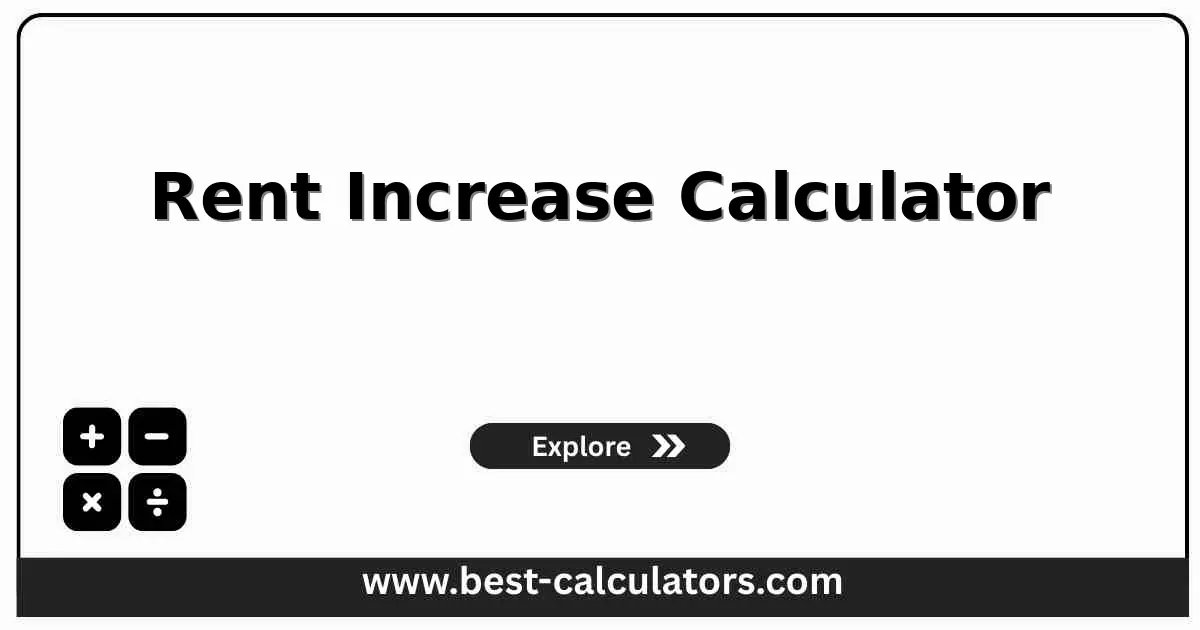Rent Increase Calculator
Free calculator to determine new monthly rent after percentage increases, with annual and total increase breakdowns
Rent Increase Calculator
Results
What is a Rent Increase Calculator?
A rent increase calculator is a free tool that determines new monthly rent amounts after percentage increases. It calculates projected rent for future years, total increase amounts, and annual cost changes, helping both landlords and tenants plan for rental adjustments.
This calculator helps with:
- Budgeting planning - Anticipate future rent costs for financial planning
- Landlord pricing - Determine fair rent increases that match market conditions
- Lease negotiations - Evaluate rent increase clauses in lease agreements
- Long-term projections - Calculate cumulative rent costs over multiple years
- Compliance verification - Ensure increases comply with local rent control laws
For rental investment analysis, use our rental property calculator to evaluate cash flow and returns after rent adjustments.
When moving mid-month, the prorated rent calculator determines fair payment for partial month occupancy.
For commission calculations on rentals, our rental commission calculator helps determine agent fees.
How Rent Increase Works
Rent increase calculation uses current rent and percentage adjustments:
Variables defined:
- Current Rent: Present monthly rental payment amount
- Increase Percentage: Annual rent adjustment rate (typically 2-5%)
- Number of Years: Time period for rent projections
- Compound vs. Simple: Whether increases apply to new rent (compound) or original (simple)
Example (Compound): $1,500 current rent, 5% annual increase, 3 years. Year 1: $1,500 × 1.05 = $1,575. Year 2: $1,575 × 1.05 = $1,653.75. Year 3: $1,653.75 × 1.05 = $1,736.44. Total increase = $236.44/month or $2,837.28/year.
Understanding rent increase calculations helps tenants budget for future housing costs and helps landlords set competitive, fair rental rates aligned with market conditions and property improvements.
Key Concepts Explained
Compound Increases
Each year's increase applies to the previous year's rent, leading to exponential growth over time.
Simple Increases
Increase percentage applies to original rent each year. Total increase is linear, not exponential.
Rent Control
Government regulations limiting allowable rent increases, typically 2-10% annually depending on jurisdiction.
Market Rate Increases
Rent adjustments based on comparable properties in the area. May exceed typical 2-5% in hot markets.
How to Use This Calculator
Enter Current Rent
Input your current monthly rental payment amount (e.g., $1,500)
Set Increase Percentage
Enter expected or proposed annual rent increase percentage (typically 2-5%)
Choose Time Period
Select number of years to project rent increases (1-30 years)
Select Calculation Method
Choose compound (increases on increases) or simple (flat percentage) method
Review Projections
See new monthly rent, monthly increase, annual cost change, and total increase
Benefits of Using This Calculator
- • Budget Planning: Anticipate future housing costs for long-term financial planning.
- • Fair Pricing: Set reasonable rent increases that balance profitability with tenant retention.
- • Lease Evaluation: Assess reasonableness of proposed increases in lease renewals.
- • Market Comparison: Compare proposed increases against market standards and inflation.
- • Investment Analysis: Project rental income growth for property investment decisions.
- • Compliance Check: Verify increases comply with local rent control regulations.
Factors That Affect Your Results
1. Inflation Rates
General inflation affects reasonable rent increases. 2-3% annual inflation often justifies similar rent adjustments.
2. Market Demand
High-demand areas support larger increases. Competitive markets may require minimal or no increases.
3. Property Improvements
Significant upgrades, renovations, or amenities may justify above-average rent increases.
4. Legal Limits
Rent control laws cap increases in many cities. Some limit to 3-5% annually regardless of market.
5. Tenant Retention
Good tenants may warrant lower increases. Turnover costs often exceed modest rent reduction benefits.

Frequently Asked Questions (FAQ)
Q: What is a fair rent increase percentage?
A: Typically 2-5% annually, matching inflation. Many jurisdictions have rent control limiting increases. Check local laws.
Q: How do you calculate rent increase percentage?
A: ((New Rent - Current Rent) ÷ Current Rent) × 100. Example: $1,000 to $1,050 = 5% increase.
Q: Are there legal limits on rent increases?
A: Yes, many areas have rent control laws limiting annual increases to 3-10%. Check local and state regulations.
Q: How often can landlords raise rent?
A: Usually upon lease renewal (annually). Month-to-month may allow more frequent increases with 30-60 day notice.
Q: What is the average annual rent increase?
A: US average typically 2-5%, varying by market, location, and property type. Hot markets see higher increases.